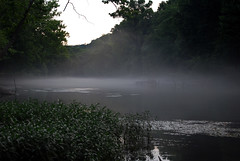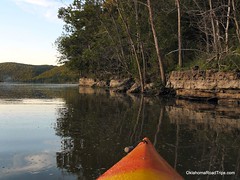By Davidson Manning
 Image by Kyro S via Flickr
Image by Kyro S via Flickr
The Niangua River may be the most overlooked trout stream in the state of Missouri. It is widely known across the state as an excellent river for floating and smallmouth bass fishing, but the trout fishery is little known. Most area trout anglers only fish in the Niangua River's tributary, Bennett Spring Branch.
Above Bennett Spring Branch, the Niangua is a typical warm-water fishery. Smallmouth bass fishing is very good, but few trout are present. It is the cooling flows from Bennett Spring that make the river into a true trout stream. For eleven miles, the water is cool enough to hold year-round populations of rainbow and brown trout. Both species are stocked regularly.
The Niangua River isn't like other trout streams in the Ozarks. First of all, it just doesn't look like a trout stream. The river is big, and it usually isn't very clear. Also, the water temperature is usually above 70 degrees for most of the summer. With that said, for some unknown reason, the Niangua River does fish well all summer long, even when water temperatures are quite high. It is not uncommon to catch trout when the water temperature is 75 degrees. In other words, it's hard to believe trout do well in the Niangua, but they do.
Rainbow trout are the most common catch in the Niangua. They are stocked every few weeks during the spring, summer, and fall, and a good number also escape from Bennett Spring Branch into the river. They are easy to catch on a Powerbait, worms, small spinners, and spoons. Brown trout are not quite as common, but a good number can be found in the river. They respond better to small crankbaits, nightcrawlers, minnows, and crayfish. Both species of trout can be caught on a variety of flies including Woolly Buggers, Prince Nymphs, Pheasant Tail Nymphs, and Caddis imitators.
 Image by Kyro S via Flickr
Image by Kyro S via Flickr
You can access the Niangua River's trout water at three points. The first is the Bennett Spring Access, where Bennett Spring Branch meets the Niangua. This is probably the most popular access point, and fish are always plentiful. The next access point is at Barclay Conservation area. This is a few miles downstream from the Bennett Spring Access. Fishing is very good in this area, especially for brown trout. The final access point is at Prosperine. Trout populations are a bit lower in this area, but you can find some of the biggest brown trout in the river both up and downstream of this access. Smallmouth bass are also abundant. Fishing regulations on the Niangua allow for all baits, lures, and flies to be used. Four trout may be kept, and there is no minimum length limit on rainbow trout. There is a 15" length limit on browns. In addition, only one brown may be kept. There are many other fantastic Missouri Trout fishing opportunities, but don't neglect this gem of a river!
No matter where you access it, the Niangua is a great stream. It may not be popular to trout fisherman, the fishing is very good. You'll see lots of floaters, especially in summertime, but fisherman will be few. This river is certainly worth a trip. If you have trouble, you can always drown your sorrows by catching a few stockers over at Bennett Springs.
Davdison Manning is an avid outdoorsman spending over 100 days per year pursuing his passion for fishing, many of them in the Ozarks of Missouri and Arkansas. He details many of his favorite spots on his website Family-Outdoors. His other pursuits include many days spent in the field camping and hunting. Davidson loves to share his knowledge of the outdoors in the hope of helping others to find their own connection to the outdoors.
![Reblog this post [with Zemanta]](http://img.zemanta.com/reblog_e.png?x-id=782795ad-9b1b-431b-beb1-7f4d70c98540)

![Reblog this post [with Zemanta]](http://img.zemanta.com/reblog_e.png?x-id=7473eb5d-342e-4c2c-9c6c-b979ab8e96fe)

![Reblog this post [with Zemanta]](http://img.zemanta.com/reblog_e.png?x-id=222df8e7-6545-4d89-9156-37c9f7afc850)

![Reblog this post [with Zemanta]](http://img.zemanta.com/reblog_e.png?x-id=3c0ecefd-6235-4f2e-9f2e-f1eac47a2376)

![Reblog this post [with Zemanta]](http://img.zemanta.com/reblog_e.png?x-id=ad3c7144-f32c-46e0-87ad-0f9f2b65b24a)

![Reblog this post [with Zemanta]](http://img.zemanta.com/reblog_e.png?x-id=f5582322-5643-4e78-8f88-99040ff7ced5)

![Reblog this post [with Zemanta]](http://img.zemanta.com/reblog_e.png?x-id=fecb0d8f-69c6-4dcc-b0aa-99b76723df09)

![Reblog this post [with Zemanta]](http://img.zemanta.com/reblog_e.png?x-id=b126def1-c8ea-42ea-9e50-2822b769c531)

![Reblog this post [with Zemanta]](http://img.zemanta.com/reblog_e.png?x-id=5bb1b2d2-01fa-4c0f-9e05-668d7e26353e)



